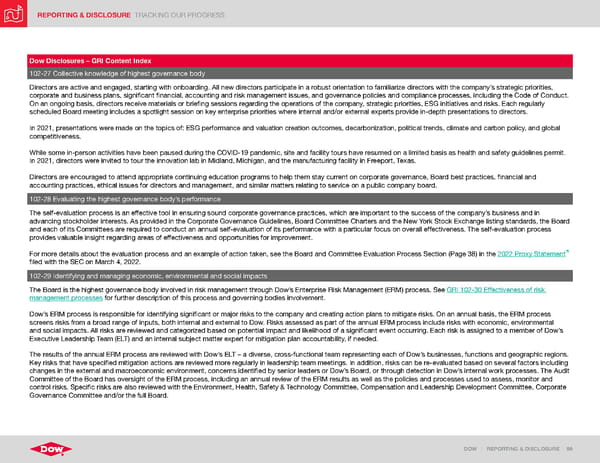REPORTING & DISCLOSURE TRACKING OUR PROGRESS DOW | REPORTING & DISCLOSURE | 99 Dow Disclosures – GRI Content Index 102-27 Collective knowledge of highest governance body Directors are active and engaged, starting with onboarding. All new directors participate in a robust orientation to familiarize directors with the company’s strategic priorities, corporate and business plans, significant financial, accounting and risk management issues, and governance policies and compliance processes, including the Code of Conduct. On an ongoing basis, directors receive materials or briefing sessions regarding the operations of the company, strategic priorities, ESG initiatives and risks. Each regularly scheduled Board meeting includes a spotlight session on key enterprise priorities where internal and/or external experts provide in-depth presentations to directors. In 2021, presentations were made on the topics of: ESG performance and valuation creation outcomes, decarbonization, political trends, climate and carbon policy, and global competitiveness. While some in-person activities have been paused during the COVID-19 pandemic, site and facility tours have resumed on a limited basis as health and safety guidelines permit. In 2021, directors were invited to tour the innovation lab in Midland, Michigan, and the manufacturing facility in Freeport, Texas. Directors are encouraged to attend appropriate continuing education programs to help them stay current on corporate governance, Board best practices, financial and accounting practices, ethical issues for directors and management, and similar matters relating to service on a public company board. 102-28 Evaluating the highest governance body’s performance The self-evaluation process is an effective tool in ensuring sound corporate governance practices, which are important to the success of the company’s business and in advancing stockholder interests. As provided in the Corporate Governance Guidelines, Board Committee Charters and the New York Stock Exchange listing standards, the Board and each of its Committees are required to conduct an annual self-evaluation of its performance with a particular focus on overall effectiveness. The self-evaluation process provides valuable insight regarding areas of effectiveness and opportunities for improvement. For more details about the evaluation process and an example of action taken, see the Board and Committee Evaluation Process Section (Page 38) in the 2022 Proxy Statement filed with the SEC on March 4, 2022. 102-29 Identifying and managing economic, environmental and social impacts The Board is the highest governance body involved in risk management through Dow’s Enterprise Risk Management (ERM) process. See GRI 102-30 Effectiveness of risk management processes for further description of this process and governing bodies involvement. Dow’s ERM process is responsible for identifying significant or major risks to the company and creating action plans to mitigate risks. On an annual basis, the ERM process screens risks from a broad range of inputs, both internal and external to Dow. Risks assessed as part of the annual ERM process include risks with economic, environmental and social impacts. All risks are reviewed and categorized based on potential impact and likelihood of a significant event occurring. Each risk is assigned to a member of Dow’s Executive Leadership Team (ELT) and an internal subject matter expert for mitigation plan accountability, if needed. The results of the annual ERM process are reviewed with Dow’s ELT – a diverse, cross-functional team representing each of Dow’s businesses, functions and geographic regions. Key risks that have specified mitigation actions are reviewed more regularly in leadership team meetings. In addition, risks can be re-evaluated based on several factors including changes in the external and macroeconomic environment, concerns identified by senior leaders or Dow’s Board, or through detection in Dow’s internal work processes. The Audit Committee of the Board has oversight of the ERM process, including an annual review of the ERM results as well as the policies and processes used to assess, monitor and control risks. Specific risks are also reviewed with the Environment, Health, Safety & Technology Committee, Compensation and Leadership Development Committee, Corporate Governance Committee and/or the full Board.
 ESG Report | Dow Page 98 Page 100
ESG Report | Dow Page 98 Page 100